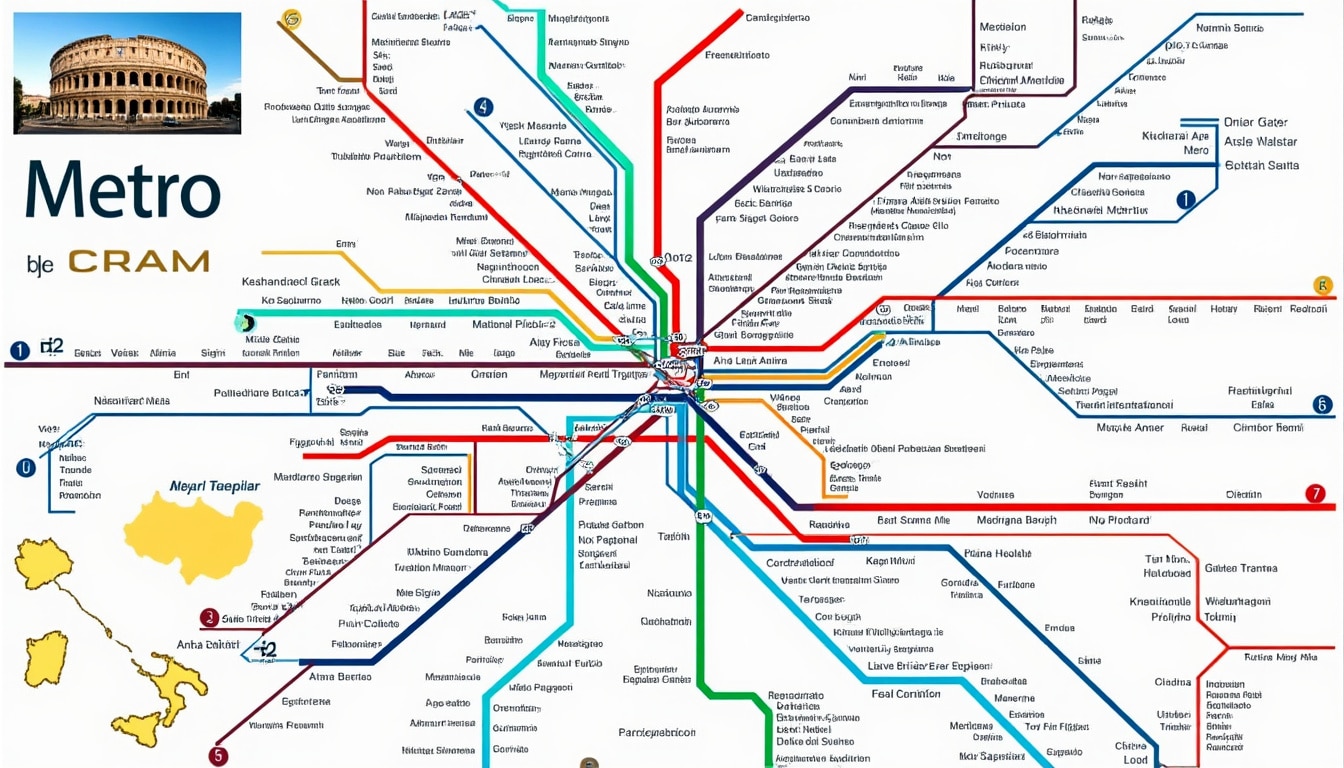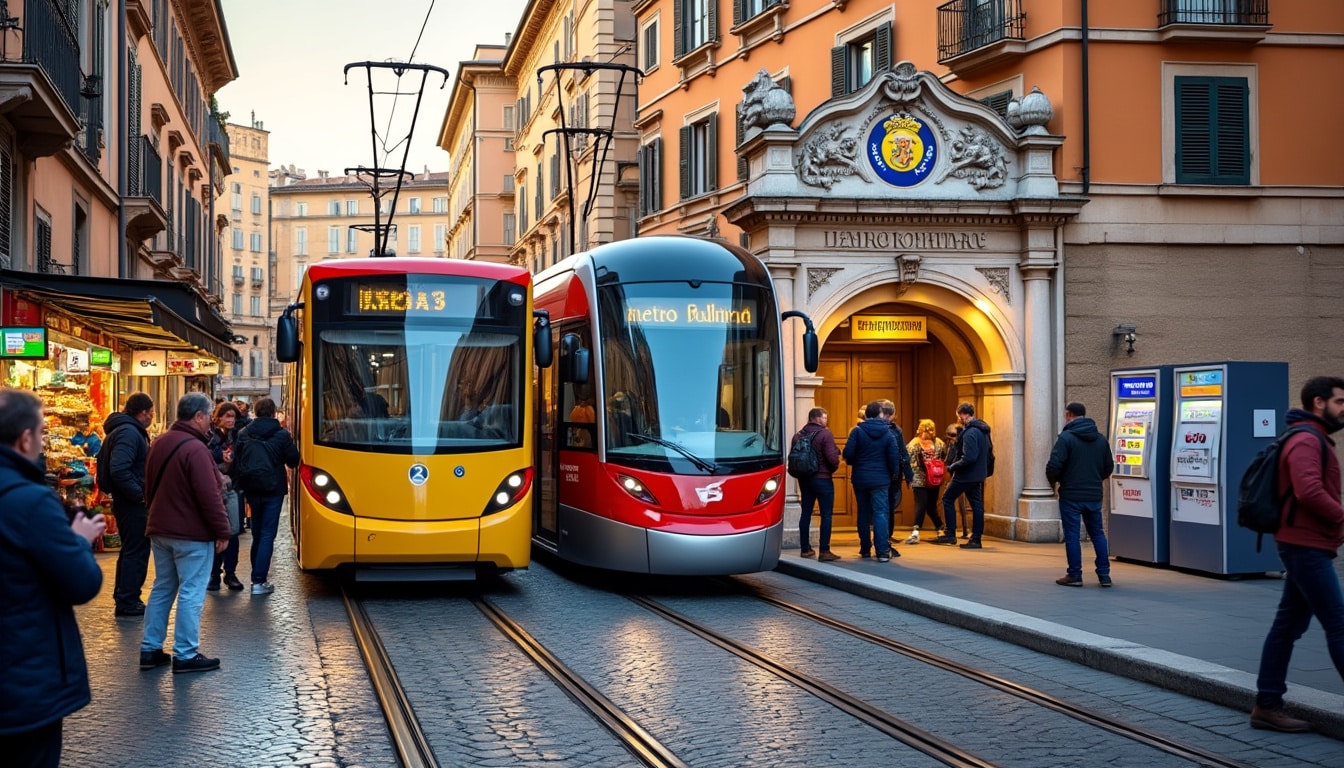Exploring the Eternal City is a mesmerizing experience with its ancient ruins, vibrant public squares, and rich cultural heritage. Yet, navigating Rome’s bustling streets can be a challenge without a good grasp of the public transport options available. Whether you’re planning to soak in the glorious sights of the Colosseum or make your way to the Vatican on time, understanding Rome’s public transport and payment systems can make your journey smoother and more enjoyable. Delve into the myriad of transport passes, understand payment options, and get handy tips to master the city’s transport network with ease.
Different Types of Public Transit Systems in Rome
Rome offers an extensive public transportation network that mixes the old-world charm with modern conveniences to help you traverse the city with ease. From the efficient yet modestly sized metro to the numerous bus routes that snake through the city, Rome certainly has a variety of options to explore. Let’s delve into the types of public transit you’ll likely encounter in your Roman adventure.
The Rome Metro 🚇
Often described as efficient and cost-effective, Rome’s metro system may not be the most extensive in Europe, but it serves as a reliable way to get around. Consisting of three lines—A (orange/red), B (blue), and C (green)—the metro connects several key tourist destinations. Lines A and B are the most commonly used by visitors, providing access to places like the Vatican and the Colosseum. However, it’s important to note that the southwest of the city center remains less connected through this system. Expect trains every 5-10 minutes during operational hours—5:30 am to 11:30 pm.
Buses and Trams 🚍
Rome’s comprehensive bus network has 338 lines and over 8000 stops, making it a flexible option for reaching every part of the city. While they run frequently, travelers should be prepared for occasional delays. Additionally, Rome’s trams operate across 6 lines covering 192 stations. Trams offer a smooth and comfortable ride, favored by those exploring the more tranquil parts of Rome. Both buses and trams run from 5:30 am to midnight, with night buses taking over after hours. It’s essential to note that hop-on-hop-off buses fall outside this public transport network.
Urban Trains 🚉
Besides the inter-city trains stopping at major hubs like Termini, Rome boasts urban trains perfect for reaching outer boroughs or venturing to scenic spots such as the cruise port of Rome, Civitavecchia. These trains are integral to the city’s transport infrastructure and a lifesaver for those staying outside the historic center.

Table of Rome’s Metro and Tram Lines
| Line | Color | Main Stops | Frequency |
|---|---|---|---|
| Line A | Orange | Vatican, Spanish Steps, Termini | Every 5-10 mins |
| Line B | Blue | Colosseum, Circus Maximus, Termini | Every 5-10 mins |
| Line C | Green | Lodi, Pigneto | Every 12-15 mins |
Buying and Using Public Transport Tickets in Rome
Navigating Rome’s public transport system begins with understanding how to buy and use tickets efficiently. This knowledge not only saves time but also enhances the convenience of traveling through the city. With various ticket options to fit different travel needs, visitors can choose what suits them best and explore the city’s historic treasures seamlessly.
Purchase Points for Tickets 🎫
Although Rome integrates a modern approach into its historic streets, purchasing public transport tickets retains a charmingly traditional aspect. Tickets cannot be purchased on-board buses or trams. Instead, you should plan to buy them in advance. Handy locations include metro stations, larger bus stops, or the numerous Tabacchi shops dotted throughout the city. Look for the ‘T’ sign, which indicates a newsagent where tickets can be bought. Furthermore, ticket machines and Atac booths within metro stations offer a quick purchasing option.
Choosing the Right Ticket 🎟️
Rome’s ticketing system is versatile, offering various durations and accessibilities. The single-use BIT ticket permits 100 minutes of access, allowing bus or tram line exchanges within this period. Those planning heavy use of public transport might find extended passes – 24-hour, 48-hour, or even weekly ones like the ATAC pass – more beneficial. If attractions are on the agenda, the Roma Pass offers significant savings, granting access to sites alongside transport privileges.
Ticket Validation ✅
To avoid fines, it is crucial to validate your ticket before starting your journey. Metro travelers can simply pass their ticket through turnstiles for automatic validation. On buses and trams, look for the yellow validation machines—insert your ticket, receive the stamped time, and you’re good to go. Remember, even if un-validated, a ticket in hand can result in penalties during inspections. Use apps like MyCicero on your smartphone to avoid ticket hassles altogether.
Table of Ticket Types and Prices
| Ticket Type | Usage Duration | Price (€) | Advantages |
|---|---|---|---|
| BIT Ticket | 100 minutes | 1.50 | Short journeys, flexibility |
| 24-hour Pass | 24 hours | 7.00 | Unlimited travel in a day |
| 48-hour Pass | 48 hours | 12.50 | Great for weekend stays |
| Week Pass (CIS) | 7 days | 24.00 | Unlimited use for frequent travelers |
Getting Around Rome: Payment Options and Mobile Apps
The ever-evolving world of technology offers a range of mobile apps and payment methods to enhance your travel experience in Rome. From planning your route to buying your ticket at your fingertips, these tools ensure a seamless journey through the city’s eclectic mix of history and modernity.
Electronic Payment Options 🔄
In 2025, electronic and contactless payments are more common globally, yet Rome retains a blend of old and new. While metro stations have embraced the tap-and-go system, traditional purchasing methods remain prevalent. The ATAC ticket machines accept contactless payments, simplifying the process. Meanwhile, buses and trams still require tickets purchased in advance, retaining a traditional touch.
Embracing Mobile Apps 📲
Several apps make public transport usage straightforward and efficient in Rome. The MyCicero app allows for electronic ticket purchases, integration with public transport schedules, and offers a repository for all your tickets. Apps like Moovit provide real-time transit information and suggest the best routes. Want to explore further afield? Check out Rome2rio, a helpful app for planning journeys beyond Rome’s core.
Table of Useful Transport Apps
| App | Features | Platform |
|---|---|---|
| MyCicero | Ticket purchases, schedule integration | iOS, Android |
| Moovit | Real-time transit updates, route planning | iOS, Android |
| Rome2rio | Multi-modal transport options, map integrations | Web, iOS, Android |
Exploring Rome with Public Transport: Travel Tips
With the ticket in hand and apps installed, it’s time to conquer Rome’s iconic streets and delve into its cultural tapestry. But how can you make the most of your transit options while ensuring a smooth journey? Here are some tips to elevate your time in the city.
Planning Your Route Efficiently 🗺️
Rome’s vast yet walkable nature means planning is crucial. Identify which areas are better reached on foot versus those where public transport will save time. Leverage apps like Moovit for mapping out your day, including transit times and expected traffic conditions. Paid tours around tourist sites are another option if you wish to save time navigating the city’s buses or metro.
Best Times to Use Public Transit ⏰
Familiarize yourself with peak travel times. Rome’s rush hours mirror that of any major city, with early mornings and late afternoons bustling with commuters. Aim for travel during mid-morning or mid-afternoon for less crowded trains and buses. On hot summer days, consider the temperatures, as transport may get sweltering during afternoon peaks.
Safety and Convenience 🛡️
Safety is paramount when using public transit. Be aware of your surroundings, especially in crowded spaces where pickpockets operate. Carrying your valuables in a secure, zipped bag minimizes risks. Familiarize yourself with the routes and stops using apps and maps—it reduces transit anxiety and enhances your confidence while exploring.
Rome’s Ticketing Options and Recommendations
Choosing the right ticket based on your travel itinerary can significantly impact your overall experience. From the flexible BIT ticket to the tourist-friendly Roma Pass, Rome’s ticket options cater to diverse travel needs and styles. Here’s a breakdown of what you should consider when selecting your ticket type.
The Versatile BIT Ticket 🔄
The BIT ticket is perfect for travelers who plan to make short trips within the city, lasting up to 100 minutes. It supports flexibility, allowing changes in bus lines without needing a new ticket, provided you remain within the time frame. Ideal for spontaneous travelers, the BIT ticket ensures you can catch a tram or bus at a moment’s notice.
Multi-Day Passes for Extended Stays 🕓
Aimed at visitors eager to dive into Rome over several days, the MetroBus pass provides unlimited access over one, two, or three-day periods. Offering great value for money, especially if you’re venturing away from central Rome, these passes enhance travel convenience.
The All-Inclusive Roma Pass 📍
More than just transport, the Roma Pass enriches the visitor experience with entry to top museum attractions. It’s a seamless solution for tourists aiming to explore cultural sites while taking full advantage of Rome’s transit system. Buying it online or from tourist offices eliminates hassle, and the perks of discounted entries complement unlimited travel.
Table of Recommended Ticket Options
| Ticket | Description | Best For |
|---|---|---|
| BIT Ticket | 100-minute single ride | Short trips, frequent line changes |
| 24/48/72-Hour Pass | Unlimited travel for respective duration | Travel-heavy days, urban adventurers |
| Week Pass (CIS) | Seven consecutive days of travel | Extended stays, public transport usage |
| Roma Pass | Transport and attraction entry included | First-time visitors, cultural explorers |
FAQs
- 🟢 What mobile app is best for planning routes in Rome? – Moovit is currently the most reliable app for real-time updates and route planning.
- 🟠 Is the Roma Pass worthwhile for tourists? – If you’re planning to visit multiple attractions and use public transport frequently, the Roma Pass offers good value.
- 🔵 Can I use contactless payments for all public transit? – As of 2025, contactless payments are mostly available at metro stations; buses and trams require tickets bought in advance.
- 🟡 What ticket is recommended for a weekend visit? – The 48-hour pass or Roma Pass best suits weekend tourists due to ease and inclusion of attraction access.
- 🟣 What’s the safest way to carry valuables on public transport? – A zipped cross-body bag is recommended to deter pickpockets and keep belongings secure.

